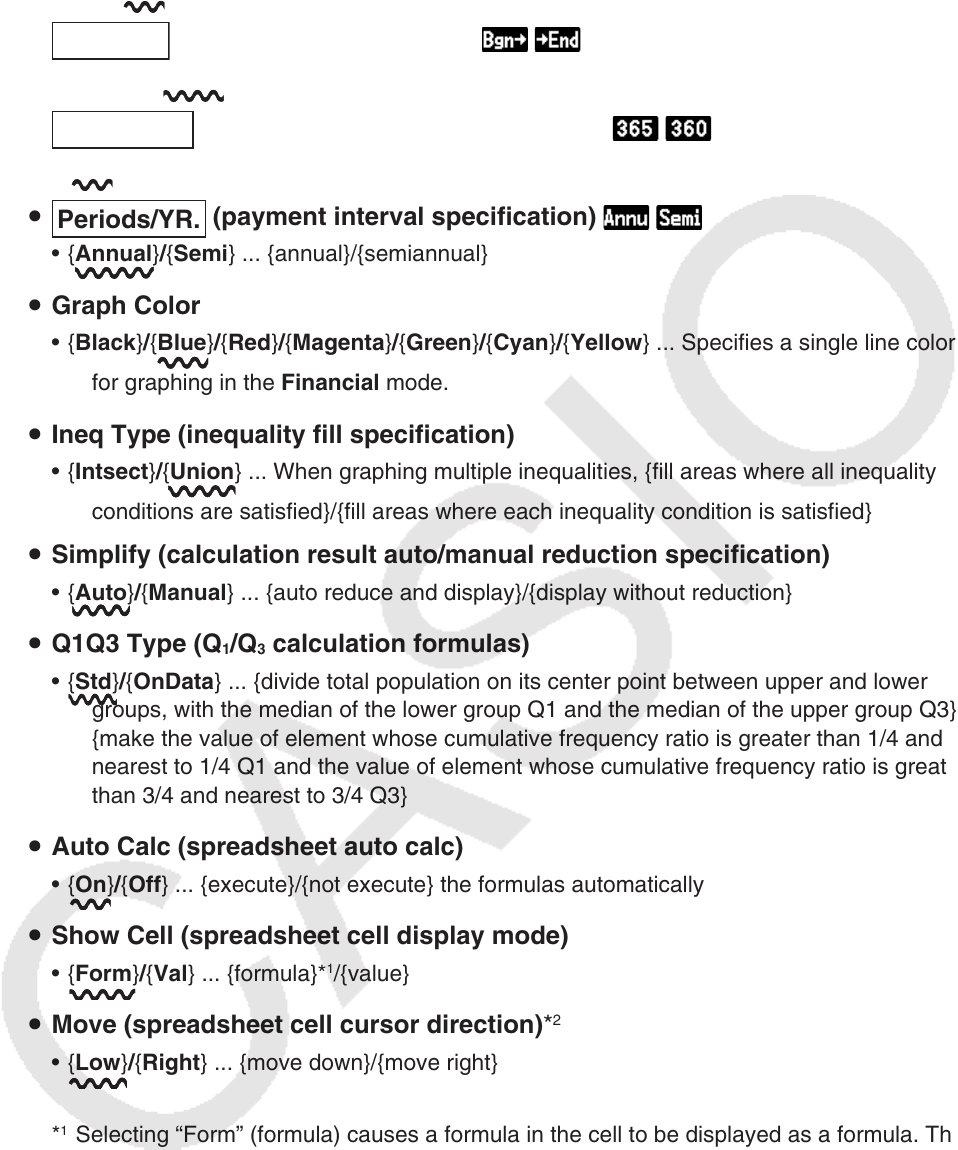User Manual
Table Of Contents
- Contents
- Getting Acquainted — Read This First!
- Chapter 1 Basic Operation
- Chapter 2 Manual Calculations
- 1. Basic Calculations
- 2. Special Functions
- 3. Specifying the Angle Unit and Display Format
- 4. Function Calculations
- 5. Numerical Calculations
- 6. Complex Number Calculations
- 7. Binary, Octal, Decimal, and Hexadecimal Calculations with Integers
- 8. Matrix Calculations
- 9. Vector Calculations
- 10. Metric Conversion Calculations
- Chapter 3 List Function
- Chapter 4 Equation Calculations
- Chapter 5 Graphing
- 1. Sample Graphs
- 2. Controlling What Appears on a Graph Screen
- 3. Drawing a Graph
- 4. Saving and Recalling Graph Screen Contents
- 5. Drawing Two Graphs on the Same Screen
- 6. Manual Graphing
- 7. Using Tables
- 8. Modifying a Graph
- 9. Dynamic Graphing
- 10. Graphing a Recursion Formula
- 11. Graphing a Conic Section
- 12. Drawing Dots, Lines, and Text on the Graph Screen (Sketch)
- 13. Function Analysis
- Chapter 6 Statistical Graphs and Calculations
- 1. Before Performing Statistical Calculations
- 2. Calculating and Graphing Single-Variable Statistical Data
- 3. Calculating and Graphing Paired-Variable Statistical Data (Curve Fitting)
- 4. Performing Statistical Calculations
- 5. Tests
- 6. Confidence Interval
- 7. Distribution
- 8. Input and Output Terms of Tests, Confidence Interval, and Distribution
- 9. Statistic Formula
- Chapter 7 Financial Calculation
- Chapter 8 Programming
- Chapter 9 Spreadsheet
- Chapter 10 eActivity
- Chapter 11 Memory Manager
- Chapter 12 System Manager
- Chapter 13 Data Communication
- Chapter 14 Geometry
- Chapter 15 Picture Plot
- Chapter 16 3D Graph Function
- Appendix
- Examination Mode
- E-CON4 Application (English)
- 1. E-CON4 Mode Overview
- 2. Sampling Screen
- 3. Auto Sensor Detection (CLAB Only)
- 4. Selecting a Sensor
- 5. Configuring the Sampling Setup
- 6. Performing Auto Sensor Calibration and Zero Adjustment
- 7. Using a Custom Probe
- 8. Using Setup Memory
- 9. Starting a Sampling Operation
- 10. Using Sample Data Memory
- 11. Using the Graph Analysis Tools to Graph Data
- 12. Graph Analysis Tool Graph Screen Operations
- 13. Calling E-CON4 Functions from an eActivity

1-38
u Slope (display of derivative at current pointer location in conic section
graph)
• {On}/{Off} ... {display on}/{display off}
u
Payment
(payment period setting)
• {BEGIN}/{END} ... {beginning}/{end} setting of payment period
u
Date Mode
(number of days per year setting)
• {365}/{360} ... interest calculations using {365}/{360} days per year
u
Periods/YR.
(payment interval specification)
• {Annual}/{Semi} ... {annual}/{semiannual}
u Graph Color
• {Black}/{Blue}/{Red}/{Magenta}/{Green}/{Cyan}/{Yellow} ... Specifies a single line color
for graphing in the Financial mode.
u Ineq Type (inequality fill specification)
• {Intsect}/{Union} ... When graphing multiple inequalities, {fill areas where all inequality
conditions are satisfied}/{fill areas where each inequality condition is satisfied}
u Simplify (calculation result auto/manual reduction specification)
• {Auto}/{Manual} ... {auto reduce and display}/{display without reduction}
u Q1Q3 Type (Q
1
/Q
3
calculation formulas)
• {Std}/{OnData} ... {divide total population on its center point between upper and lower
groups, with the median of the lower group Q1 and the median of the upper group Q3}/
{make the value of element whose cumulative frequency ratio is greater than 1/4 and
nearest to 1/4 Q1 and the value of element whose cumulative frequency ratio is greater
than 3/4 and nearest to 3/4 Q3}
u Auto Calc (spreadsheet auto calc)
• {On}/{Off} ... {execute}/{not execute} the formulas automatically
u Show Cell (spreadsheet cell display mode)
• {Form}/{Val} ... {formula}*
1
/{value}
u Move (spreadsheet cell cursor direction)*
2
• {Low}/{Right} ... {move down}/{move right}
*
1
Selecting “Form” (formula) causes a formula in the cell to be displayed as a formula. The
“Form” does not affect any non-formula data in the cell.
*
2
Specifies the direction the cell cursor moves when you press the w key to register cell
input, when the Sequence command generates a number table, and when you recall data
from List memory.










